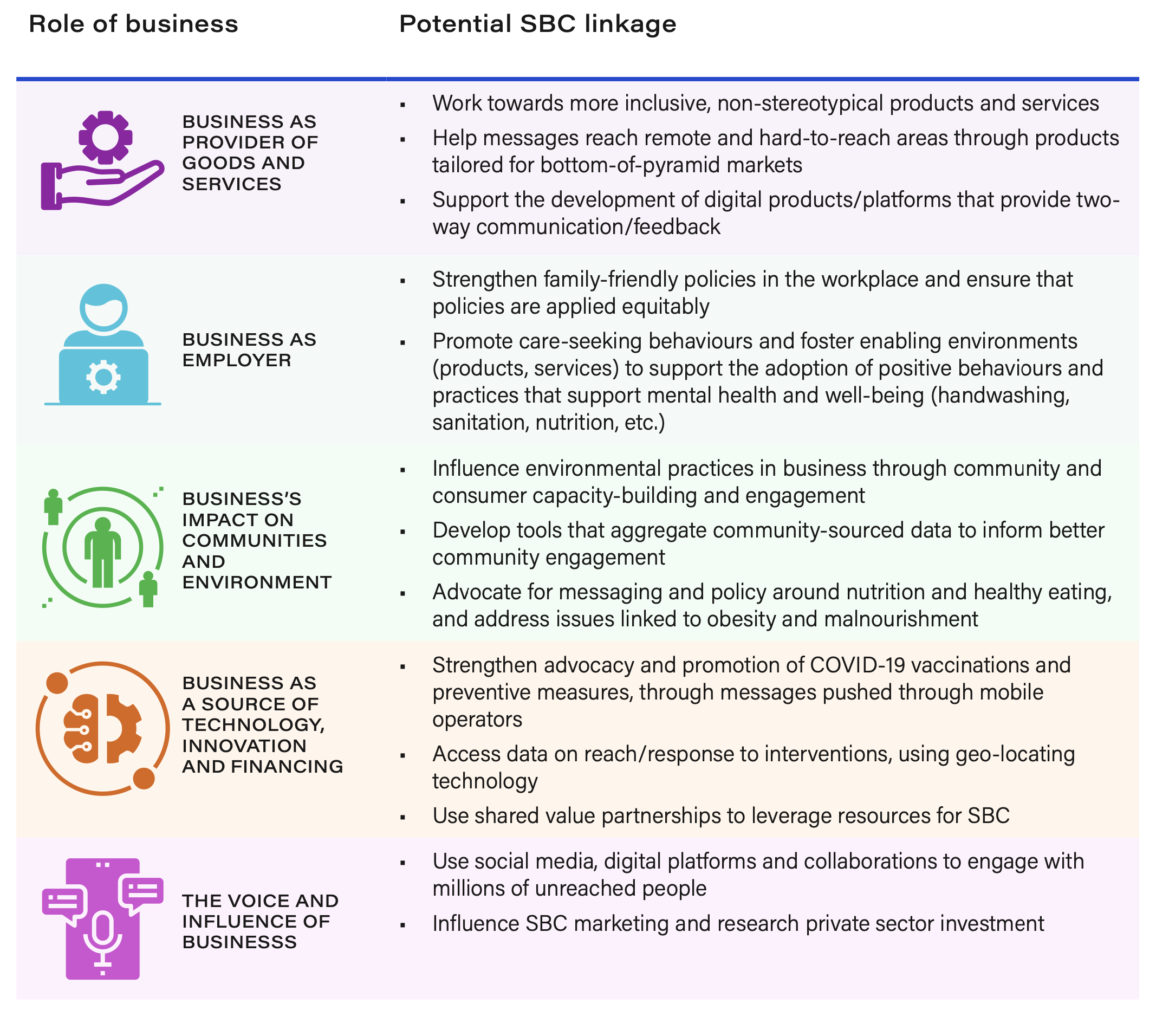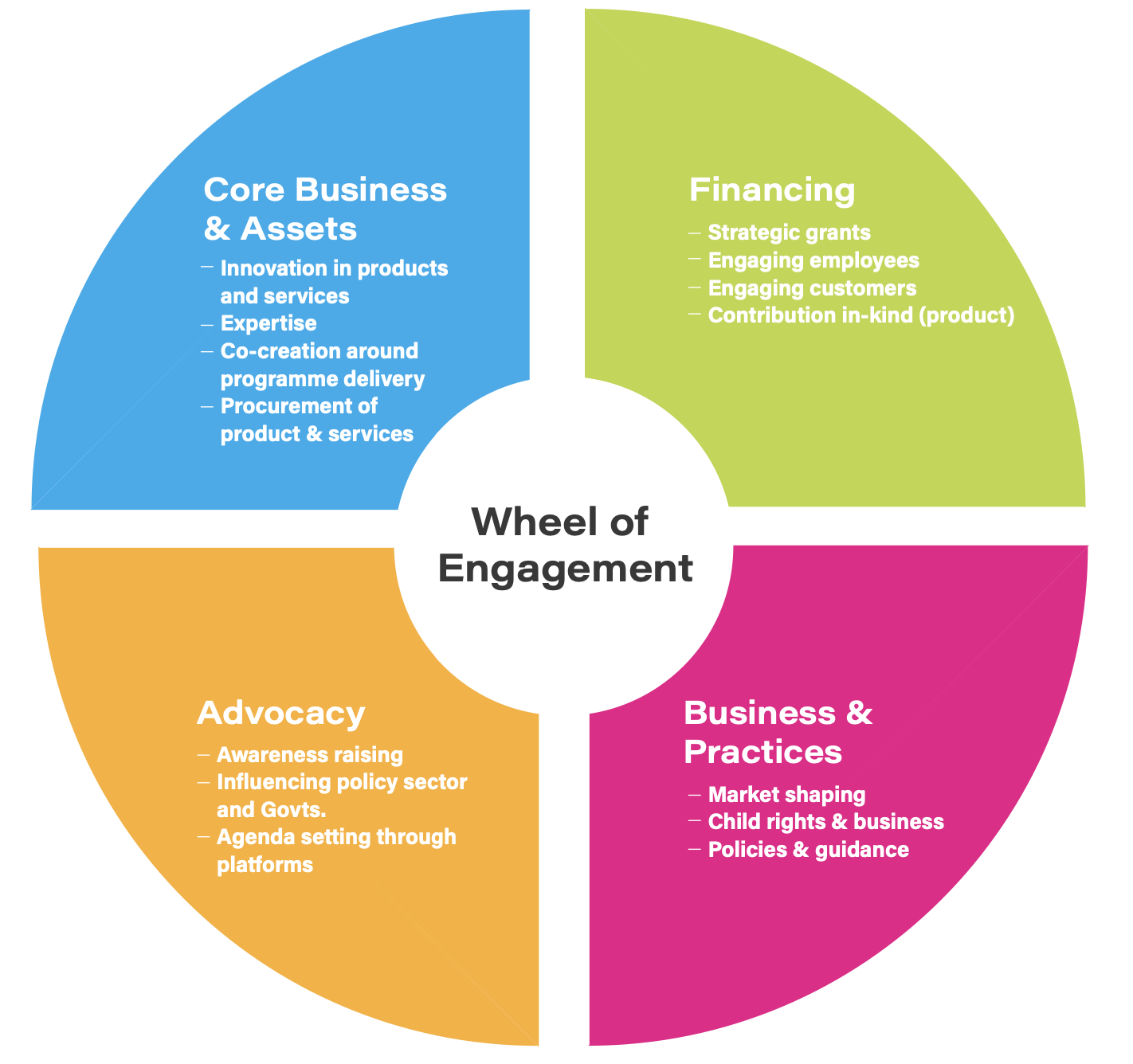
Private Sector Partnerships
Engaging with businesses for impact
Introduction
The influence of the private sector on social norms, habits and behaviours is widely acknowledged, well documented and is now more relevant to UNICEF’s work than ever before. The world of business has incredible insights, reach and resources around how people make decisions. For context, over 560 billion USD was spent on marketing and advertising in 2019 alone, with projections indicating an additional 100 billion USD being spent in 2021.
We live in a world where commercial brands, services, market practices and workplace dynamics can profoundly impact individual choices, communities and social interactions. At the same time, collective action and consumer activism are increasingly exposing and putting pressure on businesses, calling for better practices, better conduct and more respect for communities and the environment.
UNICEF is committed to using business knowledge, assets and resources to not only protect the rights of children, but to actively promote social good.This tool introduces you to UNICEF’s current business engagement work and organizational strategy to mobilize business for results, offering practical examples of how business engagement has worked for SBC and providing tips and links on how to approach this area as part of your daily work.
Benefits and social/behavioural objectives
Over the past few years, UNICEF’s engagement with the world of business has expanded in scope, incidence and impact, reflecting its commitment to maximize the multiple ways in which the private sector can support the child rights and social change agenda.
The 2022-2025 Strategic Plan renews this commitment, by outlining business engagement as a key change strategy and creating the Business For Results (B4R) agenda. B4R is an organizational effort for UNICEF offices and teams to consider and integrate the role of business as a key programming strategy in more systematic ways.
Businesses offer a huge opportunity to maximize SBC results for children. They can support UNICEF SBC work through their ability to influence workplace and marketing practices and harness corporate resources, voices and expertise. UNICEF business engagement can be instrumental in achieving SBC objectives across all programming areas. The UNICEF Programme Guidance on Engaging with Business explores some of the ways that business can contribute to UNICEF work. The table below offers some examples relevant to SBC. Note that the business sector also plays an active role in the financing and innovation of programmes.

Implementation steps and checklist
A number of considerations can help you explore if and how business can support progress towards SBC objectives. They can be summarized in 3 steps: the What, the Who, the How.
Step 1: The What
This is the link between business and the problem. Scope out business engagement with the identified SBC programme results and priorities, and consider potential interactions with the business sector. .
Key questions to ask include:
How is this business contributing to the problem? Or is this business itself the problem?
Can this business be part of the solution?
Remember that businesses can play various roles within UNICEF programme areas.
Here are important documents that can help you identify intersections and aid in the country programme planning stage:
- How to integrate the private sector into a situation analysis
- Situation analysis and the impact of business on children’s rights
- B4R Theory of Change Format Nov 2021 (UNICEF Internal ONLY)
Step 2: The WHO
Once you have identified the programme areas where business has a significant impact, you should narrow them down to a priority list. Examine the external landscape, and identify the specific business sectors and stakeholders with the reach, influence, resources and assets to help you achieve these results.
The IMPACT prospecting methodology will help you make high-quality decisions. Your decisions should follow the UNICEF approach and criteria for selecting the right partners. Be sure to review the basic procedures for engagement with business to ensure you are aligned with critical parameters.
Step 3: The HOW
Whether you find a specific business to be part of a problem or a part of the solution, what is the best way to engage with it for social good? To help identify existing options, try using the Wheel of Engagement below. This tool will help you evaluate the most impactful and effective engagement approach. It is important to remember that not all options will be applicable to any specific output or result area, and in some cases, different options may be pursued simultaneously. While leveraging monetary resources can be done in parallel with other types of engagement, it can be less effective than using the reach, influence and core assets (goods and services) of businesses.

More information on the various modalities of the Wheel of Engagement can be found in this document. The due diligence criteria and principles provide multiple documents with guidance on choosing the right type of engagement and some criteria for quality decision-making. Before reaching out to a business stakeholder, make sure to familiarize yourself with UNICEF’s Principles for engagement with business and foundations. You can also reach out to your Private Sector Engagement and Partnerships colleagues at the Country Office, Regional Office or even Programme Group. These measures will help you arrive at a shorter, more specific list of potential business sector partners. You can then initiate conversations with them, going through appropriate focal points or colleagues.
Measurement
Harnessing the power of business and brands is a strategy to achieve programmatic results through SBC. It is important to distinguish between measuring changes in outputs – such as ‘number of children reached with awareness raising and communication campaigns’ – and changes in outcomes such as ‘90% of children wash their hands after using the toilet’. The private sector tends to privilege quantitative and activity-based metrics (number of campaigns delivered, number of messages sent, number of young people accessing U-Report). When engaging with private-sector behavioural science experts, it may be helpful to develop project-specific metrics to measure activity-level or output-level results that contribute to the larger outcome or goal.
In the current Strategic Plan, UNICEF has made concerted efforts to expand and institutionalize its engagement with the business sector to achieve programmatic results for children. To help you link your SBC results to the SP 2022-2025 framework, take a look at the Change Strategy H7.
Partnerships
While following the provided methodology will help you identify specific sectors or potential partners, there are some industries and sectors with high potential that already interface with UNICEF’s SBC goals in various programmatic goal areas. These partners include local companies and big international firms. Industries and sectors potentially more pertinent to SBC include:
- Entertainment, media and film
- Social media and other digital platforms
- Food and beverage
- Beauty and consumer healthcare
- Behavioural research entities and private-sector SBC experts
- Fast-moving consumer goods (FMCG) and retail
It is important to consider the shared values and objectives from an SBC perspective when initiating new partnerships. Assess each potential partner according to 4 core dimensions: financial, business practices, advocacy and core business/assets. This will help you see partners beyond their financial benefits to leverage influence and technical collaboration. Work with your partners to conceptualize and align on shared values and objectives, contributions, responsibilities and how the quality of SBC initiatives are measured. For guidance, use the funding institution checklist in the Community Engagement Minimum Standards – Annex 2.
Case studies and examples
Both the Business For Results (B4R) platform and the UNICEF Programme Guidance on Engaging with Business offer examples of how UNICEF works to leverage business resources, expertise and assets in support of SBC programming. Here are a few examples:
![]() Leveraging product Innovation and market development to promote behavioural change around handwashing
Leveraging product Innovation and market development to promote behavioural change around handwashing
GLOBAL: UNICEF partnered with LIXIL to provide basic sanitation for 250 million people
GLOBAL: UNICEF worked with Unilever to provide access to both improved sanitation and education in Viet Nam, Brazil and india
![]() Influencing business workplace practices expertise to improve childcare practices and parenting and address stereotypes
Influencing business workplace practices expertise to improve childcare practices and parenting and address stereotypes
· BANGLADESH: UNICEF worked directly with ready-made garment factories in Bangladesh to promote optimal breastfeeding practices
· GLOBAL: UNICEF worked with the LEGO Group to dismantle stereotypes and ensure inclusivity within products, communication, marketing and experiences
![]() Policy advocacy work around food and beverage product labelling and marketing
Policy advocacy work around food and beverage product labelling and marketing
· GLOBAL: Engaging Business for Nutrition Outcomes
![]() Steering business expertise and analytics in emergencies
Steering business expertise and analytics in emergencies
· BRAZIL: UNICEF Brazil partnered with Facebook to better understand public awareness about the Zika virus. The impact of using these insights to drive the information campaign was profound: 82 per cent of those reached reported acting to protect themselves from Zika.
![]() Fostering positive messaging and action, and addressing misinformation, by leveraging private-sector reach and influence
Fostering positive messaging and action, and addressing misinformation, by leveraging private-sector reach and influence
· LEBANON: The Ministry of Information partnered with WHO, UNICEF and UNDP to stop fake news by flooding media and social media with facts and science - reaching an estimated audience of 8,383,326.
· SWEDEN: Baby Talk For Dads - UNICEF Sweden partnered with the H&M Foundation to develop a campaign for parents and caregivers, particularly fathers, to encourage positive ECD practices. An estimated 281 million individuals were exposed to the campaign.
Key resources (for UNICEF personnel)
- Programme guidance for country offices looking to engage with the private sector
- Guidance and tools for prospecting and engaging with platforms
- Principles for engagement with business and foundations
- How to integrate the private sector in a situation analysis
- Child rights and business in programme strategy notes
- UNICEF criteria and due diligence processes for private-sector partnerships
- Management of risks related to private-sector fundraising and engagement in country offices
- Developing partnerships with foundations
- Partnering with multi-stakeholder platforms
- Working with major donors

Do - Private Sector Partnerships
Download this article as a PDF
You can download the entire page as a PDF here






